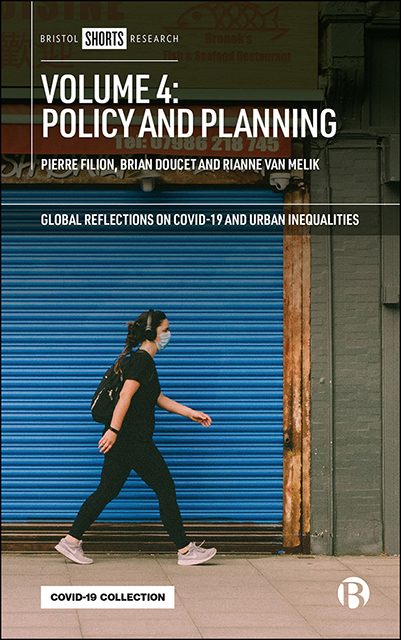Book contents
- Frontmatter
- Contents
- List of Figures and Tables
- Notes on Contributors
- Acknowledgments
- Preface to All Four Volumes of Global Reflections on COVID-19 and Urban Inequalities
- One Introduction: Policy Making in the Face of Uncertainty and Inequality
- Part I COVID-19 and Urban Changes
- Part II The Pandemic, Social Inequality, and Mobilization
- Part III Municipal and Urban Policy Responses
- Index
Four - More Cycling and Road Closures, But for Whom and Where?
Published online by Cambridge University Press: 25 April 2023
- Frontmatter
- Contents
- List of Figures and Tables
- Notes on Contributors
- Acknowledgments
- Preface to All Four Volumes of Global Reflections on COVID-19 and Urban Inequalities
- One Introduction: Policy Making in the Face of Uncertainty and Inequality
- Part I COVID-19 and Urban Changes
- Part II The Pandemic, Social Inequality, and Mobilization
- Part III Municipal and Urban Policy Responses
- Index
Summary
Introduction
Widespread ‘stay at home’ orders, closures of indoor exercise spaces, and risks of exposure to COVID-19 in public transit have prompted a significant uptake in cycling. With more cyclists on the road, the pandemic has renewed focus on the lack of safe cycling infrastructure within our cities (Hertel and Keil, 2020). Cycling infrastructure is unequally distributed, a fact now further evidenced by the pandemic, with road and lane closures for cycling occurring primarily in wealthy neighborhoods. Despite the reliance of low-income residents in ‘low-growth’ neighborhood on transit, cycling, and walking, the majority of investment remains in ‘high-growth’ higherincome neighborhoods with ample access to transportation options (Hoffmann, 2016; Grisé and El-Geneidy, 2018) (see Chapters Thirteen, Fourteen, and Fifteen for further examples of attempts to adapt urban space to active transportation during the pandemic).
Inequitable distribution of transportation infrastructure is inextricably linked to issues of race, class, gender, and capital (Stehlin, 2019; Yasin, 2020), and comes at a dire cost. Individuals who have lower-income jobs are less likely to ‘work from home’ or drive a vehicle during the pandemic. Therefore, low-income individuals are at a greater risk of infection because they have to leave their residence and take riskier modes of transportation, such as public transport. Moreover, cycling in areas with limited infrastructure increases the chance of accidents (Mayers and Glover, 2021; Tucker and Manaugh, 2018; De Vos, 2020).
Despite the high level of cycling participation by lowerincome individuals, they are largely excluded from conversations about cycling safety. Hoffmann (2016) showed that a lack of representation by lower-income individuals within powerful cycling advocacy groups is a key cause of inequitable distribution. To equitably distribute cycling infrastructure, researchers and practitioners must understand this process and its outcomes to effect change.
To do so, this chapter investigates the inequities in the cycling infrastructure decision-making process in the City of Vancouver, critiquing where resources are allocated and why.
The chapter relies on qualitative semi-structured interviews. Participants were selected based on their role and involvement in the cycling infrastructure decision-making process and recruited via email. Snowball sampling as outlined by Noy (2008), whereby each participant suggested other potential interviewees, was also used to recruit participants. All interviews took place online over Zoom or by phone.
- Type
- Chapter
- Information
- Volume 4: Policy and Planning , pp. 35 - 46Publisher: Bristol University PressPrint publication year: 2021



